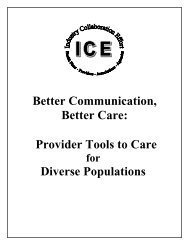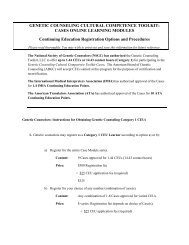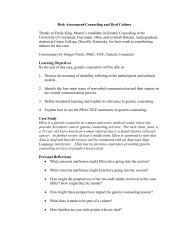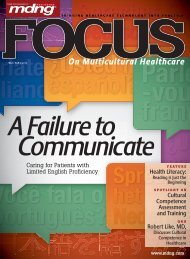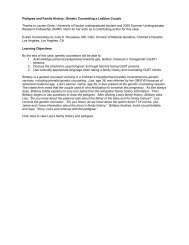Advanced Effective Communication, Cultural Competence, and ...
Advanced Effective Communication, Cultural Competence, and ...
Advanced Effective Communication, Cultural Competence, and ...
Create successful ePaper yourself
Turn your PDF publications into a flip-book with our unique Google optimized e-Paper software.
A Roadmap for Hospitals<br />
ChapterThree: Treatment<br />
Helpful Tip: Visits in the<br />
Intensive Care Unit<br />
Patients in the intensive care unit (ICU) are particularly<br />
vulnerable, may feel isolated, <strong>and</strong> commonly have complex<br />
communication needs. Many ICU patients are intermittently<br />
or continually intubated, may require the use of a<br />
continuous or bi-level positive airway pressure (CPAP or<br />
Bi-PAP) machine, or may be at various levels of sedation.<br />
These patients must have unrestricted access to their<br />
chosen support person while in the ICU to provide<br />
emotional <strong>and</strong> social support. In addition, the presence of a<br />
surrogate decision-maker to participate in care discussions<br />
<strong>and</strong> advocate on behalf of the patient is vital for the patient<br />
who is unconscious <strong>and</strong> unable to speak for him or herself.<br />
cultural, religious, or spiritual beliefs or practices. For<br />
example, in some cultures, the patient’s family may want<br />
to light c<strong>and</strong>les under the patient’s bed. The use of<br />
c<strong>and</strong>les may not be permitted in the hospital; however,<br />
one potential compromise is to suggest that the family<br />
use battery operated flashlights instead of c<strong>and</strong>les.<br />
• Note any cultural, religious, or spiritual needs that<br />
influence the patient’s care in the medical record <strong>and</strong><br />
communicate patient preferences to staff.<br />
❑ Monitor changes in dietary needs or<br />
restrictions that may impact the patient’s<br />
care.<br />
Dietary needs <strong>and</strong> restrictions should be identified during<br />
the admission <strong>and</strong> assessment processes, but new needs <strong>and</strong><br />
restrictions may arise because of the patient’s medical<br />
condition or during the course of treatment.<br />
• Inform the patient of any new dietary needs or<br />
restrictions based on his or her treatment or medications.<br />
• Note emergent dietary needs or restrictions in the<br />
medical record <strong>and</strong> communicate changes to staff.<br />
• Notify the hospital’s food service to accommodate the<br />
patient’s needs.<br />
Example Practice: Identifying<br />
Patients with <strong>Communication</strong> Needs<br />
The family of a profoundly deaf woman reported that<br />
environmental services staff had not attended to the<br />
patient’s room. Specifically, the bathroom had not been<br />
serviced <strong>and</strong> the trash had not been emptied. The<br />
environmental service provider reported that nobody<br />
responded each time she knocked on the door. Not wanting<br />
to disturb or wake a sleeping patient, she proceeded to the<br />
next patient room.<br />
While direct care staff were aware through chart review of<br />
the patient’s communication needs, other providers—<br />
whose service contributes to the patient’s quality of care<br />
<strong>and</strong> comfort—were unaware of her impaired hearing<br />
status. To address this, the hospital created a universal<br />
tracking symbol for hearing status <strong>and</strong> placed an ‘ear’ on<br />
the door of hearing impaired patients to alert all staff of the<br />
patient’s status.<br />
❑ Ask the patient to choose a support<br />
person if one is not already identified.<br />
Patients should have an opportunity to identify an<br />
individual to provide emotional support, give comfort, <strong>and</strong><br />
alleviate fear during the course of the patient’s hospital stay.<br />
The patient’s needs may change along the care continuum,<br />
<strong>and</strong> a patient who did not choose a support person at<br />
admission or assessment may choose to do so at any point<br />
during the course of treatment.<br />
• Explain the purpose of the patient’s support person,<br />
including limitations if the presence of the individual<br />
infringes on others’ rights, compromises safety, or is<br />
medically or therapeutically contraindicated.<br />
• Make staff aware the patient has chosen a support<br />
person to be present during the course of stay.<br />
• Allow the patient access to the support person at all<br />
times.<br />
• Ask if the patient would like to involve the chosen<br />
support person during rounds, patient education, <strong>and</strong><br />
other crucial decision making <strong>and</strong> care processes. The<br />
support person may or may not be the patient’s<br />
designated surrogate decision-maker.*<br />
* On April 15, 2010, President Obama released a presidential memor<strong>and</strong>um for the secretary of the Department of Health <strong>and</strong> Human Services respecting<br />
the rights of hospital patients to receive visitors <strong>and</strong> to designate surrogate decision-makers for medical emergencies regardless of their<br />
status of legally recognized immediate family members (available at http://www.whitehouse.gov/the-press-office/presidential-memor<strong>and</strong>um-hospital-visitation).<br />
(Accessed on July 22, 2010.)<br />
22


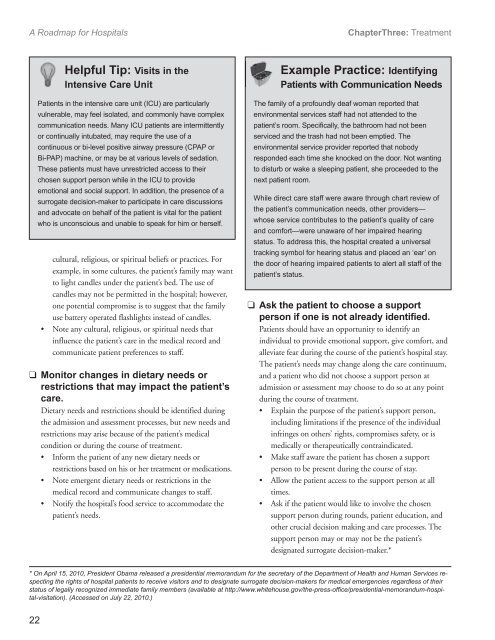
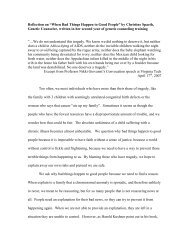
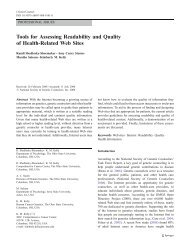

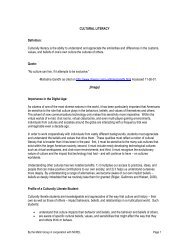
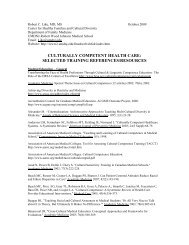

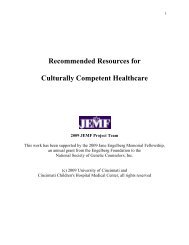

![Breaking Bad News PPT[1] - Genetic Counseling Cultural ...](https://img.yumpu.com/35003134/1/190x146/breaking-bad-news-ppt1-genetic-counseling-cultural-.jpg?quality=85)
